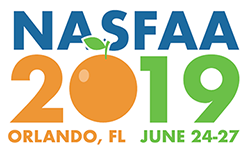Reducing Student Loan Debt: Does the Way We Award Loans Make a Difference?, 11:00 a.m. - 12:00 p.m.
By Allie Arcese, Sr. Director of Strategic Communications & Engagement
By Allie Bidwell, NASFAA Senior Reporter
The way institutions present and award loans to students could influence their behavior, according to representatives from Duke University.
During the Tuesday morning session, Irene Jasper, Andrea Dinneen, Tom Johnson, and Jill Cordell described how they tested adjusting the way loans are presented to graduate and professional students. Previously, the default on their financial aid management software was to accept all loans that were offered. The aid office had a suspicion that many students simply accepted loans they didn’t need—unaware to the fact that they could adjust loan amounts depending on how much they’d need for living expenses.
Digging into the data, they found that 58% of students accepted the maximum amount of loans offered, “not thinking about what was probably right in their situation,” Dinneen said.
The office worked with a technology company to make adjustments for an experiment. About 440 new students in the 2018-19 award year were sorted into either a control or an experimental group. In the experimental group, the office added a line to say that additional loans were available, separating direct costs like tuition and fees, and indirect costs like living expenses. A message in red at the bottom of the page directed students to use an online lending tool to request additional loans for living expenses. The default now, for the experimental group, was to get awarded just for tuition and fees, and to use the tool to determine what additional amount was right for each student. The office also noted in red at the top of the online lending tool page that they could come back at any time to borrow up to the cost of attendance—something many students didn’t know they could do.
They found that in the experimental condition, the number of students who accepted the full amounts was cut in half, and those students ended up accepting less than what was offered. On average, students accepted $5,472 less in loans. The amount, while “not massive,” Dinneen said, can have an impact over the life of a loan.
Publication Date: 6/25/2019












You must be logged in to comment on this page.